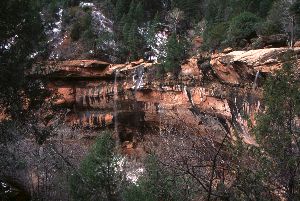 |

Themes : Focus on Water
If you want to read a little bit about the science of photography,
then start here. If you want to skip to the pictures, then you can
do that too.
Capturing the Moment
One of the interesting aspects of photography is that you are able to
freeze a moment in time. That's why it's called still photography
instead of a moving picture, or movie. As a photographer, you can
compress or extend that moment beyond what the human eye is normally
capable of.
Here's something to try, if you have the time and inclination...
Pick a "favorite" spot, and go back there every month at the
same time. Take a picture. After a year, put the 12 pictures in a row and
see what changes -- and what doesn't! -- over time. You will have captured
twelve different precise moments in time at that location.
What does that have to do with water photography? Simple! With proper
exposure techniques, you can imply motion in still photography!
The human eye perceives things now, as they exist in the moment.
At any given point in time, you can only see that point in time.
Think about it for a moment.
Seriously, go ahead, think about that for a second. Or two.
One-Mississippi... Two-Mississippi...
You're back? Great!
You are now probably wondering how water photography relates to
this idea of "perception in time". Well, it's this: A camera can take
pictures at different speeds. It all depends on how fast the shutter
opens and closes. If the shutter is open for a very short time, say 1/500th
of a second, then the film only "sees" reality for that extremely short period
of time! This allows film to perceive a moment in time that is very short.
If the shutter is open longer, say for 1 entire second, then the film
perceives a moment in time that is much longer. A lot can happen in a
second! Think about a "photo finish" during a horse race. Or think how
far a sprinter in the 100 yard dash moves!
For that reason, Sports and Action photographers trying to capture a moment
in time have to work very quickly. Shorter exposures freeze the action,
and preserve that moment! Landscape photographers are not quite
under the same time constraint. Most rocks don't move very fast.
The challenge, then, becomes showing implied motion and, therefore,
"life" in a photograph. That's where water comes in! Under normal
circumstances, a river or stream doesn't really move. That is, it
stays between its banks. But the water in the river or stream does move!
Sometimes slow, sometimes fast. But that motion can be captured in a
photograph.
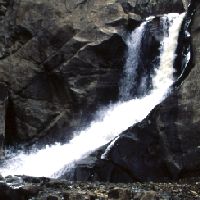 "untitled"
Boulder Falls, Colorado
|
Figure 1
Boulder Falls: Frozen in Action
Near Boulder, Colorado
Figure 1 is a picture of Boulder Falls, near Boulder, Colorado.
This picture was taken with a very short shutter speed.
Notice how the waterfall appears frozen in time? For the time that the film
was able to "see" the waterfall, the water did not move very far. In fact, it
may not have moved at all.
The implication of motion is certainly there! In fact, the picture may evoke a
number of emotions or thoughts. What do you think?
Can you hear the waterfall in your mind? Can you feel the drops spraying if
you get too close? Does this frozen moment of time make you feel like there
is energy just waiting to be unleashed?
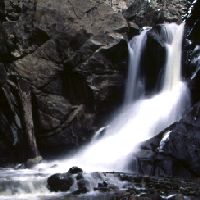 "untitled"
Boulder Falls, Colorado
|
Figure 2
Boulder Falls: Blending the Motion
Now Figure 2 is from nearly the same place as the Figure 1.
It was taken on the same day. The biggest difference,
however, was that in this case the shutter was open a lot longer. In other
words, the film "saw" the waterfall for close to one full second.
Remember the idea of an Olympic sprinter? In one second, a top-notch sprinter
can cover thirty feet! Do you think that even an Olympic sprinter is faster
than a rushing waterfall?
I doubt it. That means that this water is moving really rapidly! For the
second that the film was being exposed, each individual water drop
– maybe one of them named "Steve" – was moving along at a
rapid pace. So, instead of one short picture of Steve, the film was really
seeing Steve in about three gazillion different places. Each one of those
places become a point of exposure on the film.
The net result? The image in Figure 2.
How does the second picture make you feel, compared to
the first? I think that it has a calming effect. The smooth, silky appearance
of the water tames the raging waterfall. I think that this picture is a
much more peaceful representation of the scene. This type of picture is
often called a slip picture... I guess because the water seems to
slip by.
For me, the first picture captures pent-up energy, waiting to be
released. The water wants to move... it wants desperately to continue
falling on its course. But the film has frozen the moment in time.
When you see a waterfall "live", you can only see what it looks like at
that exact moment. You can't help it, your eyes don't work any other
way. But the camera's "eye" can
s
t
r
e
t
c
h
the moment. It can compress an entire second (or more) of reality down into
what we can look at on film. Pretty cool, huh?
You can't really expect to get good slip pictures without a tripod.
If an olympic sprinter can cover thirty feet in a second, how far do you
think your hands will move during the same time? For this and other reasons
why you need a tripod, check out my photo tips section.
If you have read this far, then thank you! I put a lot of thought and work
into my site, and I appreciate the fact that you took the time to read it.
Now, on to more pictures... this time without all of the technical talk to
go along with them!
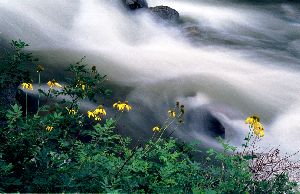 "Flowers Along Boulder Creek" Boulder Falls, Colorado Big Picture |
Keeping in mind that this page is called Focus on Water, all of the
following pictures will have water of some sort. That makes sense, doesn't it?
There is a waterfall near Boulder, Colorado, called (in a most appropriate
fashion) Boulder Falls. All of the water flowing over the falls has to go
somewhere, and this was a picture of some summer flowers along the bank of
the creek. Quite a few of the pictures on my site required a decent bit of
hiking to get to... this one is about thirty feet from a paved highway!
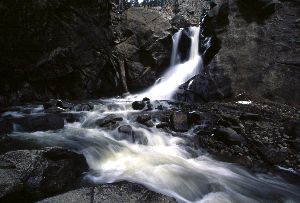 "untitled"
Boulder Falls, Colorado
|
Take the short quarter mile hike from the scene in the prior photo, and
you can see the Boulder Falls. In the Spring time, there is not a lot
of water flowing. During the Winter the falls almost freeze over! This
particular photo was taken in the fall. There is just a faint dusting of
snow on the rocks. In fact, it was actually snowing on me as I took this
picture!
This area is in a fairly narrow canyon. The best light probably occurs
during the middle of the day. Early in the morning or later in the evening
there are lots of shadows, which can make photography more challenging.
But the scenery is awesome any time of day.
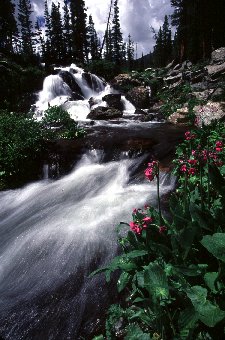 "Diamond Lake Trail" Arapaho National Forest, Colorado Big Picture |
Water often complements a picture, but the picture doesn't have to be
about water. What is your focus on this picture? Is it the waterfall?
Or is it the wildflowers in the foreground?
Good composition means that you should not have to answer that question... the
photograph should flow. Like water!
Your eye should perhaps start at the middle or back of the photograph where
the waterfall is, and naturally flow along with the stream to the foreground
where the flowers attract your attention. At least that was the way I
envisioned the photograph when I took it.
Maybe you see things the same way, maybe you don't. Either way, I hope you
enjoy the picture!
One of the advantages of a longer exposure is that the amount of water
blends together. In the picture to the right, there are actually three
waterfalls! None of the three waterfalls had a large volume of water.
By using a longer exposure, the amount of water "builds up" over time.
This picture was taken in March, in Zion National Park. This particular
scene can be viewed by taking the Emerald Pools hike. There is a Lower
Emerald Pool -- that's where the water is going. The water is coming
from the Middle Emerald Pool. And, as you might expect, there is an
Upper Emerald Pool.
The hike to the Upper Emerald Pool is longer and more primitive. The
hike to the Lower Emerald Pool is quite easy, and wheelchair accessable.
It is only a short walk from the Lower Emerald Pool to the place where
I took this picture. The path does get icy in colder months, so be careful!
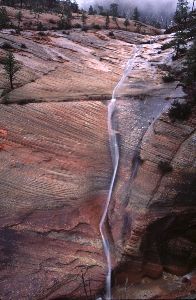 "Spring Shower Runoff" Zion National Park, Utah Big Picture |
Zion is a photographer's dream. It has such a wide variety of places and
things to photograph... you never quite feel like you have finished. I
have been there a number of times, and have every intention of returning
again.
The lower portion of the park surrounds the Virgin River. The river has
cut an incredible canyon called the Zion Narrows. In some places it is
over 2,000 feet deep... but still only 30 or 40 feet across! Evil Knievel
would not have found much of a challenge here... I am told that hiking
the Narrows is quite an experience. I am definitely going to do this some day.
The picture to the left is a bit more tame. I was standing on the road in
the upper portion of the park. We had driven past this point on a number
of times during our vacation in Zion, but this time it was raining. The
simple addition of water to the scene made for an incredible photo
opportunity.
The water collects and quickly runs off of the sandstone cliffs. For this
picture I was standing in the rain, using my hat to cover my camera while
I took a lengthy exposure to blend the water together. My head got wet,
but my camera stayed dry. And I got what I think is one of my favorite
pictures from the trip.
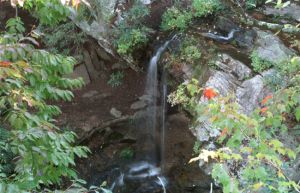 "Window Rock Falls" Hanging Rock State Park, North Carolina Big Picture |
Using the concept of time to increase density can be very rewarding when
taking pictures of delicate waterfalls. This picture is from Hanging Rock
State Park in North Carolina. The waterfall drops over a cliff, which you
can see. Under the cliff is a "window" in the rock that allows you to climb
through to the other side. Thus the name: Window Rock Falls.
There is just a faint hint of fall color in the leaves. There were quite a
few visitors at the park on this weekend, so I had to wait a while to get
a picture that didn't have any people in it.
Finally, this last picture in the Water Tour turns out to be water of a
different form: Ice! One of the most geologically interesting hikes in
Colorado is the hike to Hanging Lake. I will have more about this hike
at some point on my Colorado page. For the
short version...
Hanging Lake is so named because it appears to "hang" on the side of a cliff.
There is a hole in the side of the mountain above it that spouts water, which
gives it the name Spouting Rock. Do you get the feeling that the people who
named these features were going for the obvious?
In the colder seasons, the waterfall from Spouting Rock often freezes solid.
During one of my hikes, I went around behind the frozen waterfall and took
the picture below. The sunlight filtering through the ice provides the
excellent blue color. And before anyone asks, the answer is "Yes, the picture
is right-side up."
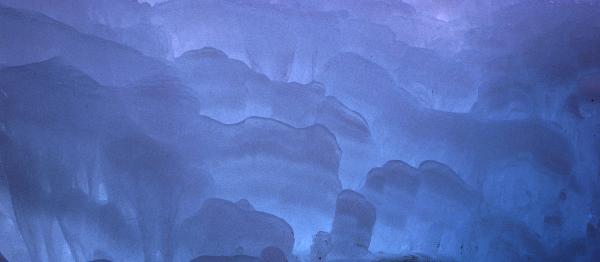 "Behind the Ice"
Hanging Lake, Colorado
|
This concludes my Focus on Water photo tour.
I hope that you enjoyed it! You can return to the
themes page, or start over
here. Thank you for taking a look!
|
|








|






